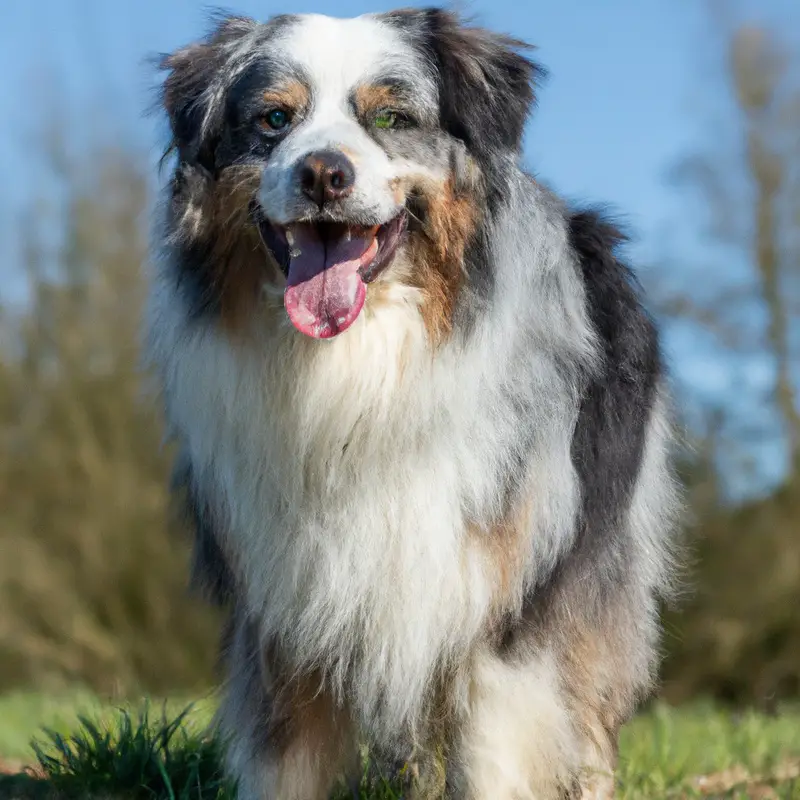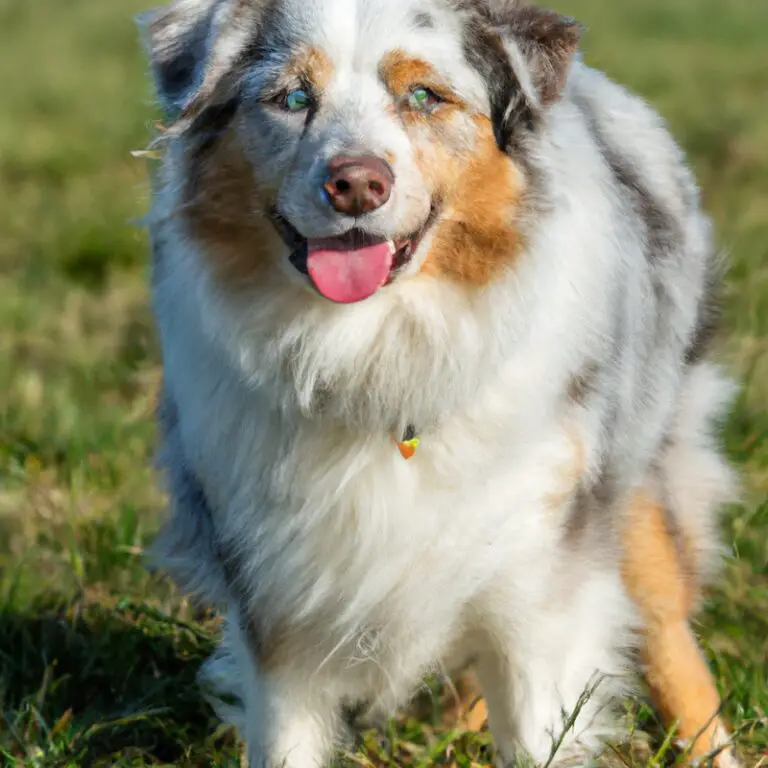What Are The Best Training Methods For Teaching An Australian Shepherd To Drop Objects?
Key Takeaways:
- Positive reinforcement is the most effective training method for teaching an Australian Shepherd to drop objects.
- Incorporating interactive games and mental stimulation can enhance the training process.
- Consistency and patience are crucial for successfully teaching an Australian Shepherd to drop objects.
- Using a “drop” cue and gradually increasing the difficulty level of the training can yield positive results.
Are you struggling to get your Australian Shepherd to let go of objects? Trust me, I’ve been there too.
Teaching an Australian Shepherd to drop objects can be a challenge, but fear not, because I’m here to share the best training methods that have worked for me and countless other dog owners.
In this article, I’ll delve into the key characteristics of Australian Shepherds, the importance of teaching the “drop” command, and the benefits it brings. I’ll also discuss the potential challenges you might face along the way.
So grab a cup of coffee and get ready to learn some effective techniques to help your Aussie become a pro at dropping objects!
| Training Method | Description | Pros | Cons |
|---|---|---|---|
| Reward-based training | Using positive reinforcement with treats or praise to encourage the dog to release the object voluntarily | Effective: Australian Shepherds are highly food-motivated and respond well to rewards | Time-consuming: It may take several sessions to achieve desired results |
| Clicker training | Using a clicker to mark the desired behavior and rewarding the dog for dropping the object | Precise: Clicker training helps to clearly communicate the desired action | Requires equipment: You will need a clicker to practice this method |
| Trade-off method | Using a desirable item or treat to trade for the object the dog is holding | Effective: Teaches the dog that releasing the object leads to something better | Dependent on value: The value of the trade item may play a role in the effectiveness |
Understanding the Australian Shepherd Breed
Key Characteristics of Australian Shepherds
Australian Shepherds are known for their distinctive characteristics. They are intelligent, active, and agile dogs.
These medium-sized dogs have a strong work ethic and are highly trainable.
Australian Shepherds are incredibly loyal and make great companions. They have a beautiful double coat that requires regular grooming.
These dogs thrive in an environment where they have plenty of mental and physical stimulation.
Australian Shepherds are highly energetic and require daily exercise to prevent boredom and destructive behaviors. It’s important to provide them with outlets for their energy, such as agility training or outdoor activities.
Additionally, Australian Shepherds are natural herders and may try to herd other animals, including children or smaller pets.
Early socialization and proper training are essential for managing this behavior. Overall, Australian Shepherds are intelligent, active, and loyal dogs that thrive in an environment where they have plenty of mental and physical stimulation.

Behavioral Traits to Consider
When considering training methods for an Australian Shepherd, it’s important to understand their behavioral traits. Here are some key traits to consider:
- Intelligence: Australian Shepherds are highly intelligent dogs. This means they can pick up new commands quickly, but it also means they may become bored with repetitive training exercises. Variety and mental stimulation are key.
- Herding Instinct: Australian Shepherds have a strong herding instinct, which can sometimes manifest as nipping or chasing behaviors. Channeling this instinct into productive activities, such as obedience training or agility exercises, can be beneficial.
- Energy Level: These dogs have a lot of energy and require regular exercise to stay happy and healthy. Incorporating physical activities into their training routine, like fetch or long walks, can help burn off excess energy and make them more receptive to training.
- Focus and Attention: Australian Shepherds have a natural tendency to be alert and attentive. This can make them easier to train as they are eager to please. However, it’s important to keep training sessions short and engaging to maintain their focus.
- Strong Bonding: Australian Shepherds are known for their loyalty and strong bond with their owners. This can be a great asset when it comes to training, as they are motivated to please their humans. Positive reinforcement and praise go a long way in motivating them.
Understanding these behavioral traits can help you tailor your training methods to suit your Australian Shepherd’s needs. By keeping them mentally and physically stimulated, and utilizing positive reinforcement techniques, you can successfully teach them to drop objects and any other commands you want to introduce.

Importance of Teaching “Drop” Command
Benefits of Teaching “Drop” Command
Teaching the “Drop” command to your Australian Shepherd comes with several benefits. Firstly, it promotes safety for both your dog and yourself.
If your dog picks up something hazardous, like a toxic substance or a sharp object, being able to command them to drop it immediately can prevent any potential harm.
Additionally, teaching the “Drop” command helps in preventing resource guarding behavior. By training your dog to willingly let go of objects, you can minimize possessive tendencies and create a more harmonious environment.
Moreover, teaching the “Drop” command helps in improving your dog’s overall obedience and responsiveness.
It enhances their understanding of commands and strengthens the bond between you and your furry friend.
Potential Challenges in Teaching “Drop” Command to Australian Shepherds
Teaching the “Drop” command to Australian Shepherds can come with its own set of challenges. One potential challenge is their natural herding instinct, which can make them reluctant to release objects.
Additionally, Australian Shepherds are known for their high energy levels and can get easily distracted during training sessions.
Another challenge is their intelligence, as they may try to outsmart you or become stubborn when learning new commands. It’s important to be patient, consistent, and use positive reinforcement methods to overcome these challenges.
Positive Reinforcement Training Methods
Using Treats and Rewards
Using treats and rewards is a highly effective method for teaching an Australian Shepherd to drop objects. It’s a positive reinforcement technique that encourages desired behaviors by rewarding them with something the dog finds rewarding, such as a tasty treat or a favorite toy.
When the dog drops the object on command, they are rewarded with the treat or toy.
This method not only incentivizes the dog to drop the object but also creates a positive association with the command. Here are a few key points to keep in mind when using treats and rewards:
- Choose high-value treats that your Australian Shepherd really loves. This will make the reward more enticing and increase the likelihood of success.
- Use a clear and consistent command, such as “drop” or “release,” when requesting your dog to drop the object. This will help them understand the desired behavior.
- Immediately reward your dog when they drop the object as directed. Timing is crucial in reinforcement training, so make sure to praise and give the treat right after the behavior occurs.
- Gradually reduce the frequency of treats as your dog becomes more proficient in dropping objects. Eventually, you can transition to intermittent rewards or substitute treats with verbal praise and petting.
Using treats and rewards in training is a positive and effective way to teach your Australian Shepherd to drop objects. It creates a positive association with the command and encourages your dog to repeat the desired behavior.
Remember to be patient, consistent, and always end each training session on a positive note.

Clicker Training Technique
Clicker training is a popular and effective technique for teaching dogs new behaviors, including dropping objects. The clicker is a small handheld device that makes a distinct clicking sound when pressed.
I use this tool to mark the exact moment my Australian Shepherd successfully performs the desired behavior.
Here’s how it works:
- Choose a specific sound: Start by associating the clicker sound with a treat. Simply click the device and immediately give your dog a treat. Repeat this several times to establish a positive connection between the click and the reward.
- Timing is key: As your dog starts to understand the connection between the click and the treat, you can begin to use the clicker to mark the desired behavior. For example, when teaching your Australian Shepherd to drop an object, click the moment they release the item from their mouth.
- Follow up with a reward: After you click, make sure to reward your dog with a treat or praise immediately. This reinforces the behavior and lets them know that they did something right.
Remember, clicker training is all about positive reinforcement and clear communication. It helps your Australian Shepherd understand exactly what you want from them and encourages them to repeat the desired behavior in the future.
So, give clicker training a try when teaching your Australian Shepherd to drop objects.
It’s a fun and effective technique that can strengthen your bond with your furry friend.
Progressive Training Approach
Progressive training is an effective approach when teaching an Australian Shepherd to drop objects. This method involves breaking down the training process into small steps and gradually increasing difficulty.
I start by rewarding the Shepherd for simply releasing an object and then progress to dropping it on command.
By gradually increasing the distractions and challenges, I ensure that the Shepherd understands and responds to the “drop” command in different situations. This approach helps the dog learn at their own pace and builds a strong foundation for reliable obedience.
Targeted Training Exercises for Teaching “Drop”
“Leave It” Exercise
The “Leave It” exercise is an essential tool in teaching your Australian Shepherd to drop objects. It involves teaching your dog to resist the temptation of grabbing or engaging with something you want them to leave alone.
Here’s how you can do it:
- Start with a treat in your closed hand and let your dog sniff it.
- Close your hand tightly when they try to get it.
- Say “leave it” firmly and wait for them to stop trying. Only when they do, open your hand and offer the treat.
- Repeat this exercise several times, gradually increasing the time they need to wait before getting the treat.
- Once they understand “leave it” with treats, you can introduce other objects, such as toys or items they may find interesting.
- Practice the exercise in different environments, with distractions, and gradually reduce the use of treats, using praise and rewards instead.
Remember to be patient and consistent with the “leave it” exercise. It may take some time for your Australian Shepherd to fully grasp the concept, but with practice and positive reinforcement, they will learn to drop objects on command.
“Give” Exercise
The “Give” exercise is a powerful tool in teaching your Australian Shepherd to drop objects on command. Here’s how it works:
- Start with a favorite toy or treat in your hand.
- Say the command “Give” in a firm but gentle tone.
- Open your hand to show the object and encourage your dog to take it.
- Once your dog has the item in their mouth, hold a treat near their nose. This will naturally make them want to drop the object to get the treat.
- As your dog drops the object, say “Good” or use a clicker to mark the behavior, and immediately give them the treat.
Repeat this exercise regularly, gradually increasing the difficulty by using different objects and practicing in various locations. Remember to keep the training sessions short and engaging, and always end on a positive note.
With consistency and patience, your Australian Shepherd will master the “Give” command in no time.
“Drop It” Exercise
In the “Drop It” exercise, the goal is to teach your Australian Shepherd to release an object on command. This is an important command to prevent them from holding onto objects they shouldn’t have or potentially harmful items.
To start the exercise, hold a toy or object in your hand that your dog is interested in.
Give the command “drop it” in a firm but calm voice. If your dog doesn’t release the object, gently take it out of their mouth without forcefully pulling.
Once you have the object, offer a treat or another toy as a reward.
Repeat the process several times, gradually increasing the duration between the command and the reward to encourage your dog to hold off on dropping the object until commanded. It’s important to be patient and consistent with this exercise.
Practice it in different environments and gradually introduce distractions to ensure your Australian Shepherd can obey the “drop it” command in any situation.
Remember to always use positive reinforcement and rewards to reinforce the behavior you want.
Consistency and Patience in Training
Importance of Consistent Commands
Consistent commands are crucial when training an Australian Shepherd to drop objects. When you use the same verbal cue, such as “drop” or “let go,” every time you want your dog to release something, it helps them understand what you want them to do.
Consistency reinforces the desired behavior and makes it easier for your dog to learn and respond.
Without consistent commands, your dog may become confused and not know what is expected of them. By using the same command consistently, you establish clear communication between you and your dog, which is essential for successful training.
Patience as a Virtue in Training
In training your Australian Shepherd to drop objects, patience is key. It’s important to remember that learning takes time and each dog is different.
It can be frustrating at times, but it’s essential to remain calm and patient throughout the training process.
Rushing or getting frustrated may hinder progress and can even create negative associations with training. By staying patient, you give your dog the space and time needed to understand and respond to your commands.
So take a deep breath, be patient, and enjoy the journey of training your Australian Shepherd.
Good luck!
Troubleshooting Common Challenges
Handling Resource Guarding Behavior
Handling resource guarding behavior can be challenging, but with patience and the right approach, you can help your Australian Shepherd overcome this behavior. Resource guarding occurs when a dog becomes possessive and aggressive over certain objects or areas.
It’s important to address this behavior to prevent any potential harm or conflicts.
One effective method is desensitization and counter-conditioning. Start by gradually introducing your dog to the object they guard, such as their food bowl or a toy.
Use positive reinforcement techniques, like giving treats or praise, whenever your dog remains calm and relaxed around the object.
This helps create a positive association and reduces their urge to guard. Another approach is to teach a “drop it” or “leave it” command.
With consistent training, your dog can learn to willingly release objects without feeling the need to guard them.
Start by offering a low-value item and rewarding your dog for dropping it. Gradually increase the value of the item and practice the command in different settings to reinforce the behavior.
It’s crucial to avoid punishment or forceful methods when dealing with resource guarding behavior.
Instead, focus on building trust and a positive connection with your dog. Seek the guidance of a professional dog trainer if you’re struggling with this behavior, as they can provide personalized advice and support.
Remember, handling resource guarding behavior requires patience and understanding.
By using positive reinforcement techniques and seeking professional help when needed, you can help your Australian Shepherd overcome this challenging behavior.
Dealing with Distractions
When training an Australian Shepherd to drop objects, dealing with distractions is a common challenge. These intelligent and high-energy dogs can easily get distracted by their surroundings, making it difficult to focus on the training.
To overcome this challenge, it’s essential to gradually introduce distractions during the training process.
Start in a quiet and controlled environment, ensuring that your dog understands the “drop” command without any distractions. Then, slowly add distractions such as noises, people, or other animals.
During training sessions, use high-value treats or rewards to grab your dog’s attention and keep them motivated.
Reinforce the “drop” command consistently, even when distractions are present. It may take some time and patience, but with practice, your Australian Shepherd will learn to ignore distractions and focus on the task at hand.
Additionally, it can be helpful to train in different locations to expose your dog to various distractions.
This will help them generalize the “drop” command and respond appropriately in different situations. Remember, consistency is key in reinforcing the desired behavior and minimizing distractions.
If you find that your Australian Shepherd is struggling with distractions, consider using a leash or long line during training sessions.
This will give you more control and prevent them from wandering off or being too easily lured by distractions. Gradually increase the level of distractions as your dog becomes more proficient in dropping objects.
Overall, dealing with distractions is a normal part of training an Australian Shepherd to drop objects.
By gradually introducing distractions, using high-value rewards, and maintaining consistency, you can help your dog overcome this challenge and successfully master the “drop” command. Keep practicing and be patient, and your Australian Shepherd will eventually learn to ignore distractions and focus on your commands.
Addressing Stubbornness in Training
Addressing stubbornness in training can be a common challenge, especially with breeds like Australian Shepherds known for their strong-willed nature. When dealing with a stubborn dog, it’s essential to approach training with patience and consistency.
One effective technique is to break down the training tasks into smaller, more manageable steps.
This helps prevent your Australian Shepherd from feeling overwhelmed and increases their chances of success. By gradually increasing the difficulty level of each task, you can help your dog overcome their stubbornness and achieve the desired behavior.
Another helpful tip is to use positive reinforcement techniques.
Rewarding your dog with treats, praise, or play when they exhibit the desired behavior encourages them to repeat it. This positive association makes training more enjoyable for your dog and reinforces their motivation to learn.
Consistency is crucial when dealing with stubbornness in training.
Ensure that you use the same commands and cues consistently, and reinforce the desired behavior every time. This helps your Australian Shepherd understand what is expected of them and reduces confusion.
If you encounter challenges or feel that your dog’s stubbornness is hindering progress, don’t hesitate to seek professional help.
A qualified dog trainer can offer guidance tailored to your specific situation and provide you with effective strategies to address stubbornness in training. Remember, addressing stubbornness requires patience, consistency, and a positive approach.
By employing these methods and seeking professional assistance when needed, you can help your Australian Shepherd become more responsive and obedient during training sessions.
Tailoring Training to the Individual Dog
Recognizing Your Dog’s Learning Style
Recognizing your dog’s learning style is an important aspect of effective training. Every dog is unique and has different ways of understanding and processing information.
By recognizing your dog’s learning style, you can tailor your training methods to suit their needs and help them learn more effectively.
Some dogs are visual learners and respond well to demonstrations and visual cues. They may benefit from watching you perform the desired behavior before attempting it themselves.
Using hand signals along with verbal commands can also be helpful for visual learners.
Other dogs are auditory learners and respond better to verbal cues and commands. They may pick up on the tone and inflection of your voice, so it’s important to speak clearly and consistently during training sessions.
Using verbal praise and encouragement can also be motivating for auditory learners.
Kinesthetic learners, on the other hand, learn best through physical experiences and hands-on activities. They may benefit from interactive training exercises that require them to physically engage with objects or obstacles.
Incorporating play and physical rewards can also be effective for kinesthetic learners.
It’s also important to consider your dog’s overall personality and temperament. Some dogs are highly motivated by treats and food rewards, while others may be more motivated by toys or praise.
Understanding what motivates your dog can help you choose the most effective rewards during training.
By recognizing and understanding your dog’s learning style, you can modify your training techniques to best suit their needs. This will make the training process more enjoyable and successful for both you and your Australian Shepherd.
Modifying Training Techniques for Each Dog
When it comes to training our dogs, it’s important to remember that each dog is unique. This means that their learning style and preferences may vary.
As a result, it’s crucial to modify our training techniques to suit each individual dog.
By doing so, we can ensure that our training sessions are effective and enjoyable for both us and our furry friends. One way to modify training techniques is by recognizing your dog’s learning style.
Some dogs may respond better to visual cues, while others may prefer verbal commands.
By paying attention to how your dog best understands and retains information, you can tailor your training approach accordingly. Another way to modify training techniques is by considering your dog’s personality and temperament.
Some dogs may be more sensitive or timid, requiring a gentler and more patient training approach.
On the other hand, some dogs may be more energetic or stubborn, requiring more structure and consistency in their training. It’s also important to adapt the training techniques based on your dog’s specific needs and goals.
For example, if you’re working on teaching your Australian Shepherd to drop objects, you may need to focus more on the “release” command and incorporate specific exercises to reinforce this behavior.
Overall, modifying training techniques for each dog involves understanding their individuality, preferences, and goals. By doing so, you can create a training plan that is tailored to your dog’s needs and set them up for success.
So, remember to be adaptable, patient, and observant as you train your beloved four-legged companion.
Expert Tips for Successful Training
Keeping Training Sessions Short and Engaging
When it comes to training your Australian Shepherd to drop objects, keeping your training sessions short and engaging is crucial. Dogs, including Australian Shepherds, have short attention spans, so it’s important to keep their focus and motivation high during training.
By keeping your training sessions short, you’re able to maintain your dog’s interest and prevent them from becoming bored or distracted.
Aim for training sessions that are around 10-15 minutes long, multiple times throughout the day. This allows your dog to stay engaged and actively participate in the training process.
To make sure your training sessions are engaging, incorporate a variety of activities and exercises.
Use positive reinforcement techniques such as treats, toys, and praise to reward your Australian Shepherd when they perform the desired behavior, such as dropping an object. This positive reinforcement will create a positive association with the training sessions and motivate your dog to participate.
Additionally, make the training sessions fun and interactive.
Use games, like fetch or hide-and-seek, to keep your dog excited and engaged. Vary the training environment, practicing the “drop” command in different locations to help your dog generalize the behavior.
Remember, training should be a positive experience for both you and your dog.
Keep the sessions short, keep them engaging, and always end on a positive note. This will help you and your Australian Shepherd achieve success in teaching the “drop” command.
Seeking Professional Help if Needed
If you’re having difficulty training your Australian Shepherd to drop objects, seeking professional help is always a good option. A professional dog trainer can provide expert guidance and techniques tailored to your dog’s specific needs.
They have experience working with different breeds, including Australian Shepherds, and can help address any challenges or behavioral issues you may be facing.
Don’t hesitate to reach out for professional assistance to ensure successful training for your furry friend.
Being Consistent Outside of Training Sessions
Consistency is key not only during training sessions but also in your day-to-day interactions with your Australian Shepherd. Being consistent outside of training sessions helps reinforce the lessons learned and ensures that your dog understands what is expected of them at all times.
One way to be consistent is by using the same commands and cues consistently.
For example, if you’re teaching your dog to “drop it,” make sure to use the same phrase every time you want them to release an object. Using different words or phrases will only confuse your dog and make the training process more difficult.
Consistency also means following through with the rules and boundaries you’ve established.
If you’ve taught your dog not to jump on the furniture, for example, it’s important to enforce this rule consistently. Allowing your dog on the couch occasionally will only send mixed signals and make it harder for them to understand what is expected of them.
Additionally, consistency extends to your reactions and responses.
If your dog displays unwanted behavior, such as stealing food from the counter, it’s important to respond consistently each time. This could involve redirecting their attention, using a corrective cue, or simply removing the dog from the situation.
Consistency in your responses will help your dog understand which behaviors are inappropriate.
Overall, being consistent outside of training sessions will reinforce the lessons learned and help your Australian Shepherd understand and follow the rules and commands consistently. It may require some effort and patience on your part, but the results will be worth it.
Final Verdict
Teaching an Australian Shepherd to drop objects requires patience, consistency, and effective training methods. Positive reinforcement techniques such as using treats and rewards, clicker training, and a progressive training approach have proven to be successful.
Targeted exercises like the “Leave It,” “Give,” and “Drop It” exercises can be tailored to the individual dog’s learning style.
Troubleshooting common challenges like resource guarding and distractions should be addressed with appropriate techniques. Remember to keep training sessions short and engaging, seek professional help if needed, and maintain consistency outside of training sessions.
With these methods and tips, you can successfully train your Australian Shepherd to drop objects and foster a strong bond between you and your furry friend.







